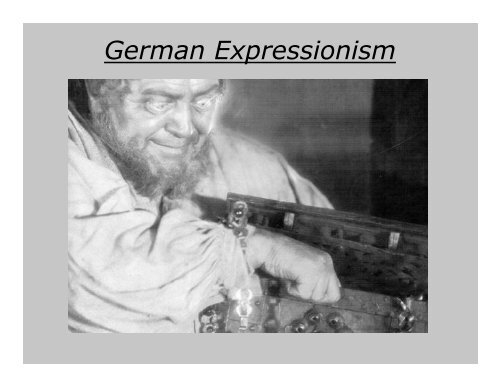German Expressionism - Adam P. Wadenius
German Expressionism - Adam P. Wadenius
German Expressionism - Adam P. Wadenius
You also want an ePaper? Increase the reach of your titles
YUMPU automatically turns print PDFs into web optimized ePapers that Google loves.
<strong>German</strong> <strong>Expressionism</strong>
<strong>German</strong> <strong>Expressionism</strong><br />
• <strong>German</strong> <strong>Expressionism</strong> evolves as a reaction against<br />
realism. Its practitioners favored extreme distortion to<br />
express an inner emotional reality rather than surface<br />
appearances.<br />
Kirchner’s “Baigneurs” (1909) Kirchner’s “Women on the Street” (1914)<br />
• Expressionist painting avoids the shading, colors,<br />
volume, and depth of realist paintings. Instead,<br />
Expressionists use large shapes of bright, unrealistic<br />
colors with dark, cartoonlike outlines.
<strong>German</strong> <strong>Expressionism</strong><br />
• The goal of Expressionist film is to express feelings in<br />
the most direct and extreme fashion possible.<br />
Das testament des Dr. Mabuse (1927)<br />
Die Nibelungen (1927)<br />
• Figures might be elongated; faces wear grotesque,<br />
anguished expressions. Buildings might sag or lean,<br />
with the ground tilted up steeply in defiance of<br />
traditional perspective.
<strong>German</strong> <strong>Expressionism</strong><br />
• <strong>German</strong> <strong>Expressionism</strong> is distinctive primarily for<br />
its use of mise-en-scène.<br />
Formal Characteristics<br />
Faust (1926)<br />
- Human figure<br />
- Stylized surfaces<br />
- Symmetry<br />
- Distortion &<br />
Exaggeration<br />
• In Expressionist films, the expressivity associated<br />
with the human figure extends into every aspect of<br />
the mise-en-scène.
<strong>German</strong> <strong>Expressionism</strong><br />
• <strong>German</strong> <strong>Expressionism</strong> is distinctive primarily for<br />
its use of mise-en-scène.<br />
Formal Characteristics<br />
Nosferatu (1922)<br />
- Human figure<br />
- Stylized surfaces<br />
- Symmetry<br />
- Distortion &<br />
Exaggeration<br />
• Expressionist films employ stylized surfaces<br />
(costumes, sets, patterns), and often juxtapose<br />
similar shapes within a composition.
<strong>German</strong> <strong>Expressionism</strong><br />
• <strong>German</strong> <strong>Expressionism</strong> is distinctive primarily for<br />
its use of mise-en-scène.<br />
Formal Characteristics<br />
Metropolis (1927)<br />
- Human figure<br />
- Stylized surfaces<br />
- Symmetry<br />
- Distortion &<br />
Exaggeration<br />
• Combining actors, costumes, and sets so as to<br />
emphasize overall composition gives Expressionist<br />
films a sense of symmetry.
<strong>German</strong> <strong>Expressionism</strong><br />
• <strong>German</strong> <strong>Expressionism</strong> is distinctive primarily for<br />
its use of mise-en-scène.<br />
Formal Characteristics<br />
Raskolnikow (1923)<br />
- Human figure<br />
- Stylized surfaces<br />
- Symmetry<br />
- Distortion &<br />
Exaggeration<br />
• The most obvious and pervasive trait of <strong>Expressionism</strong><br />
is the use of distortion and exaggeration. Houses are<br />
often pointed and twisted, chairs are tall, staircases are<br />
crooked and uneven.
Das kabinett des Doktor Caligari<br />
Directed by Robert<br />
Weine<br />
Written by Hans<br />
Janowitz and Carl<br />
Mayer<br />
Decla Bioscope-AG,<br />
1920. 51 minutes.
<strong>German</strong> <strong>Expressionism</strong><br />
• Expressionist narrative also functions to convey<br />
character subjectivity.<br />
Narrative Conventions<br />
Wachsfigurenkabinett (1924)<br />
- Emphasis on<br />
fantasy<br />
- Self-contained<br />
stories<br />
• <strong>Expressionism</strong> was often used for narratives that<br />
were set in the past or in exotic locales or that<br />
involved elements of fantasy or horror
<strong>German</strong> <strong>Expressionism</strong><br />
• Expressionist narrative also functions to convey<br />
character subjectivity.<br />
Narrative Conventions<br />
Tartuffe (1926)<br />
- Emphasis on<br />
fantasy<br />
- Self-contained<br />
stories<br />
• Many Expressionist films have frame stories or<br />
self-contained stories embedded within the larger<br />
narrative structure.
Der Golem<br />
Directed by Carl<br />
Boese and Paul<br />
Wegener<br />
Written by Henrik<br />
Galeen and Paul<br />
Wegener<br />
Projektions-AG Union,<br />
1920. 83 minutes.



